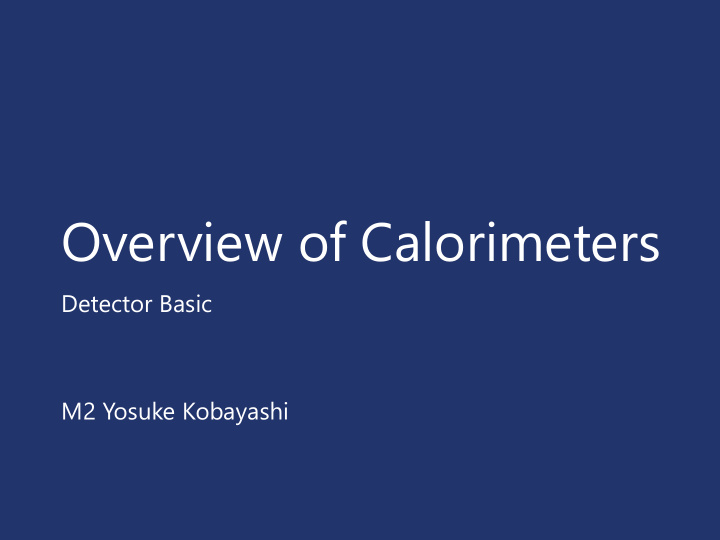



Overview of Calorimeters Detector Basic M2 Yosuke Kobayashi
Contents Electromagnetic Calorimeter • Introduction to Calorimeter • ECal • Sampling calorimeter • Global layout Forward Calorimeter • LumiCal • BeamCal • Pair Monitor 2
Introduction to Calorimeter • Calculate the energy of the original particle by measuring the shower energy generated from the particle. • ILC uses a technique called Particle Flow Algorithm (PFA) to achieve high shower energy resolution. PFA is a method to measure • charged particles with a TPC and neutral particles with a calorimeter. 3
The Electromagnetic Calorimeter • The electromagnetic calorimeter (ECal) uses electromagnetic shower to measure electrons and photons. • To increase compactness and particle separation ability, choice of a sampling calorimeter. 4
Sampling calorimeter • The sampling calorimeter is composed of a combination of an absorption layer and a detection layer. absorbers ➢ tungsten detectors ➢ scintillator ➢ silicon sensor 5
Global layout of the ECAL • To achieve an adequate energy resolution, the ECAL is longitudinally segmented into around 30 layers. • The active layers are segmented into cells with a lateral size of 5 − 10 mm to reach the required pattern recognition performance. Layout of the ECal 6
Contents Electromagnetic Calorimeter • Introduction to Calorimeter • The Electromagnetic Calorimeter • Sampling calorimeter • Global layout Forward Calorimeter • LumiCal • BeamCal • Pair Monitor 7
LumiCal & BeamCal • An R&D program is ongoing to develop the technologies for detectors for precision measurements in a new energy domain. • In ILD and SiD detectors two specialized calorimeters are foreseen in the very forward region, LumiCal for the precise measurement of the luminosity. • BeamCal for a fast estimate of the luminosity and for the control of beam parameters. • Both will also improve the hermeticity of the detector 8
LumiCal • With LumiCal the luminosity will be measured using Bhabha scattering, 𝑓 + 𝑓 − → 𝑓 + 𝑓 − (𝛿) , as a gauge process. Bhabha scattering • To match the physics benchmarks, an accuracy of better than 10 −3 is needed at a centre-of-mass energy of 500 GeV. • For the GigaZ option, where the ILC will be operated for precision measurements at CM energies around the Z boson, an accuracy of 10 −4 would be required. 9
BeamCal • BeamCal is positioned just outside the beam-pipe. • At ILC energies we have to tackle here a new phenomenon – the beamstrahlung. • When electron and positron bunches collide, the particles are accelerated in the magnetic field of the bunches towards the bunch centre. • This so called pinch effect enhances the luminosity. e e - + Pinch effect 10
beamstrahlung • However, electrons and positrons may radiate photons. • A fraction of these photons converts in the Coulomb field of the bunch particles creating low energy e + e − pairs. e - e + Pair creation Beamstrahlung e - 𝛿 e + Pinch effect 11
Pair Monitor • These depositions, useful for a bunch-by-bunch luminosity estimate and the determination of beam parameters, will lead, however, to a radiation dose of about one MGy per year in the sensors at lower polar angles. • Hence radiation hard sensors are needed to instrument BeamCal.BeamCal is supplemented by a pair monitor. • Pair monitor give additional information for the beam parameter determination. 12
Recommend
More recommend